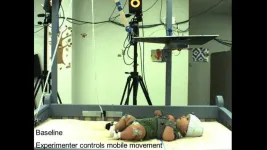Modeling the minutia of motor manipulation with AI
An AI research collaboration led by EPFL professor Alexander Mathis creates a model which provides deep insights into hand movement, which is an essential step for the development of neuroprosthetics and rehabilitation technologies
2024-10-01
(Press-News.org)
In neuroscience and biomedical engineering, accurately modeling the complex movements of the human hand has long been a significant challenge. Current models often struggle to capture the intricate interplay between the brain's motor commands and the physical actions of muscles and tendons. This gap not only hinders scientific progress but also limits the development of effective neuroprosthetics aimed at restoring hand function for those with limb loss or paralysis.
EPFL professor Alexander Mathis and his team have developed an AI-driven approach that significantly advances our understanding of these complex motor functions. The team used a creative machine learning strategy that combined curriculum-based reinforcement learning with detailed biomechanical simulations.
Mathis's research presents a detailed, dynamic, and anatomically accurate model of hand movement that takes direct inspiration from the way humans learn intricate motor skills. This research not only won the MyoChallenge at the NeurIPS conference in 2022, but the results have also been published in the journal Neuron.
Virtually controlling Baoding balls
“What excites me most about this research is that we’re diving deep into the core principles of human motor control—something that’s been a mystery for so long. We’re not just building models; we’re uncovering the fundamental mechanics of how the brain and muscles work together” says Mathis.
The NeurIPS challenge by Meta motivated the EPFL team to find a new approach to a technique in AI known as reinforcement learning. The task was to build an AI that precisely manipulate two Baoding balls—each controlled by 39 muscles in a highly coordinated manner. This seemingly simple task is extraordinarily difficult to replicate virtually, given the complex dynamics of hand movements, including muscle synchronization and balance maintenance.
In this highly competitive environment, three graduate students—Alberto Chiappa from Alexander Mathis’ group, Pablo Tano and Nisheet Patel from Alexandre Pouget’s group at the University of Geneva—outperformed their rivals by a significant margin. Their AI model achieved a 100% success rate in the first phase of the competition, surpassing the closest competitor. Even in the more challenging second phase, their model showed its strength in ever more difficult situations and maintained a commanding lead to win the competition.
Breaking the tasks down in smaller parts – and repeat
“To win, we took inspiration from how humans learn sophisticated skills in a process known as part-to-whole training in sports science,” says Mathis. This part-to-whole approach inspired the curriculum learning method used in the AI model, where the complex task of controlling hand movements was broken down into smaller, manageable parts.
“To overcome the limitations of current machine learning models, we applied a method called curriculum learning. After 32 stages and nearly 400 hours of training, we successfully trained a neural network to accurately control a realistic model of the human hand,” says Alberto Chiappa.
A key reason for the model’s success is its ability to recognize and use basic, repeatable movement patterns, known as motor primitives. In an exciting scientific twist, this approach to learning behavior could inform neuroscience about the brain’s role is in determining how motor primitives are learned to master new tasks. This intricate interplay between the brain and muscle manipulation points to how challenging it can be to build machines and prosthetics that truly mimic human movement.
“You need a large degree of movement and a model that resembles a human brain to accomplish a variety of everyday tasks. Even if each task can be broken down into smaller parts, each task needs a different set of these motor primitives to be done well,” says Mathis.
Harness AI in the exploration and understanding of biological systems
Silvestro Micera, a leading researcher in neuroprosthetics at EPFL’s Neuro X Institute and collaborator with Mathis, highlights the critical importance of this research for understanding the future potential and the current limits of even the most advanced prosthetics. “What we really miss right now is a deeper understanding of how finger movement and grasping motor control are achieved. This work goes exactly in this very important direction,” Micera notes. “We know how important it is to connect the prosthesis to the nervous system, and this research gives us a solid scientific foundation that reinforces our strategy.”
END
[Attachments] See images for this press release:


ELSE PRESS RELEASES FROM THIS DATE:
2024-10-01
Patients who receive umbilical cord blood transplants for blood cancers now live equally long regardless of their race, new research from UVA Cancer Center shows.
The findings, from UVA Health’s Karen Ballen, MD, and collaborators, suggests that a previously identified survival gap for Black recipients has closed and that overall survival for all recipients has increased.
The retrospective analysis looked at more than 2,600 adults and children with blood cancers who received cord blood between 2007 and 2017 ...
2024-10-01
DALLAS, Oct. 1, 2024 – Strokes can strike at any age, challenging survivors to overcome physical, emotional and cognitive changes. Nominations are open now for the 2025 Stroke Hero Awards from the American Stroke Association, a division of the American Heart Association, which is celebrating a century of lifesaving impact this year. The awards recognize stroke survivors, caregivers, advocates and experts making a difference in the stroke community.
Every 40 seconds someone in the U.S. has a stroke[1], according to the American Heart Association’s 2024 Heart Disease and Stroke Statistical Update. Nearly 1 in 4 stroke survivors face the ...
2024-10-01
Seven years after actor Alyssa Milano’s tweet launched the #MeToo movement into the global consciousness, attitudes towards sexual harassment and assault have shifted in many countries. A new study shows that the movement’s impact doesn’t stop there.
INSEAD professors Frédéric Godart and David Dubois, alongside Clément Bellet of Erasmus University Rotterdam, found that #MeToo triggered far-reaching changes in consumer behaviour. Sales of stereotypically feminine shoes like high heels dropped significantly weeks after the #MeToo movement swept the media ...
2024-10-01
INDIANAPOLIS – The pandemic has highlighted the acute shortage of nurses and nursing assistants needed to care for the growing number of older adults in long-term care facilities. Yet getting nursing students excited, engaged and feeling competent to take on the challenges of caring for nursing home patients has proved elusive.
To address this critical workforce gap, researchers from Regenstrief Institute and the Indiana University School of Medicine have developed and tested an innovative curriculum for nursing students, exposing ...
2024-10-01
The first-ever nationwide study into how Australians use and dispose of clothing has revealed people are buying too many clothes and are unsure how to discard them responsibly.
Conducted by RMIT University and commissioned by the Kmart Group and the Queensland Government, a study of 3,080 Australians explored how they acquired, used and disposed of their clothing.
Australians are among the world’s biggest clothing consumers, importing 1.4 billion units or over 383,000 tonnes annually.
But each year, more than 200,000 tonnes of clothing is sent to landfill.
The authors recommend establishing a national textile collection program for unwearable clothing that ...
2024-10-01
Scientists need fine spatial and temporal resolution land surface temperature (LST) data for many types of research and applications. Spatio-temporal fusion, a technique that combines data from multiple sources to create high-resolution images with both spatial (space) and temporal (time) details, is an important solution for researchers needing fine spatio-temporal resolution LST data. A team of researchers propose a new spatio-temporal fusion method based on Restormer (RES-STF).
Their work is published in the Journal of Remote Sensing on August 21, 2024.
LST data, the measurement ...
2024-10-01
Recent advances in computing and artificial intelligence, along with insights into infant learning, suggest that machine and deep learning techniques can help us study how infants transition from random exploratory movements to purposeful actions. Most research has focused on babies’ spontaneous movements, distinguishing between fidgety and non-fidgety behaviors.
While early movements may seem chaotic, they reveal meaningful patterns as infants interact with their environment. However, we still lack understanding of how infants intentionally engage with their surroundings and the principles guiding their ...
2024-10-01
NEW YORK, NY (Oct. 1, 2024) – Systemic racism remains a significant challenge in efforts to address health disparities in childhood asthma. A new American Thoracic Society report provides practical frameworks to begin the research necessary to make real progress in treating asthma in Black and Latino children, who are more likely than their white counterparts to report to emergency rooms in the U.S.
Stephanie Lovinsky-Desir, MD, and a diverse group of researchers, clinicians, social scientists and community health workers shared their findings in the report published online this week in ...
2024-10-01
Dr. Jaeyeon Pyo of the Smart 3D Printing Research Team at the Korea Electrotechnology Research Institute (KERI) has developed a breakthrough technology that uses light to visualize nanoscale glass microcapillary tips, enabling precise and delicate contact with other objects.
A “‘Microcapillary” is a precision tool with a very small aperture (0.1 mm to 0.000010 mm in diameter) fabricated from a glass tube. It is utilized as a vital tool in various fields, from biotechnology to manipulate cells, to micro electroplating and nano 3D printing. Specifically, it is used in biotechnology faor tasks such as injecting sperm into an egg during in vitro fertilization (IVF) ...
2024-10-01
Seattle, WA – October 1, 2024 – The BRAIN Initiative® Cell Atlas Network (BICAN) has launched its first major data release, marking a significant milestone in the ambitious effort to map the whole human brain.
The data, accessible through the BICAN Rapid Release Inventory, includes single-cell and single-nucleus transcriptomic and epigenomic profiles from humans, mice, and 10 other mammalian species. Sourced from multiple grants and labs within the consortium, including the Allen Institute, these data are from projects that aim to identify and define brain cell types based on molecular profiles.
“The ...
LAST 30 PRESS RELEASES:
[Press-News.org] Modeling the minutia of motor manipulation with AI
An AI research collaboration led by EPFL professor Alexander Mathis creates a model which provides deep insights into hand movement, which is an essential step for the development of neuroprosthetics and rehabilitation technologies









